Menu
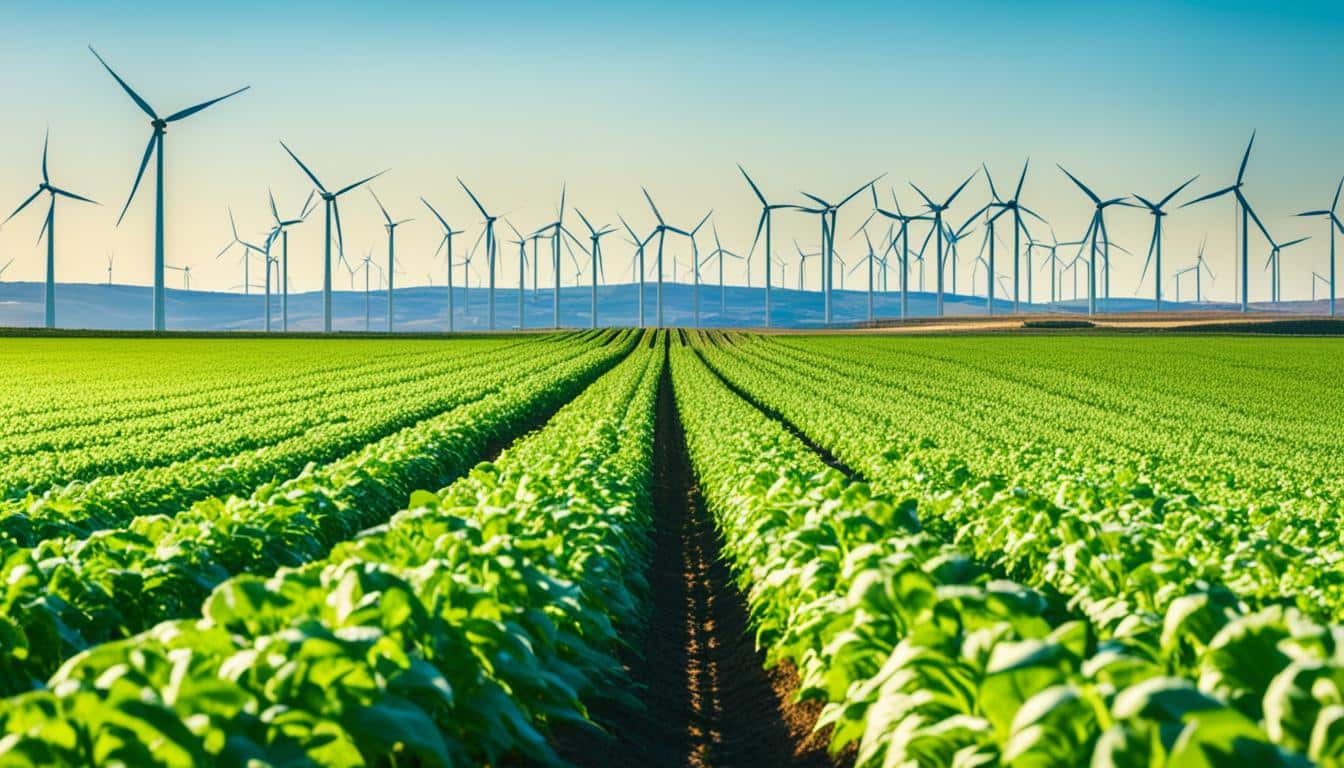
By ditching synthetic nitrogen fertilisers in organic farming, we can cut a fifth of global agricultural greenhouse gases. Agriculture leads to over 30% of these emissions. This offers a key way to make a big difference for our planet. I’m devoted to going greener in farming by trying out new organic methods.
The ‘carbon footprint’ is the total amount of greenhouse gases caused by a person, group, or thing. Farming greatly contributes to these gases. So, turning to organic ways is a smart move. It can lead to a big drop in our carbon footprint. With better organic farming, we aim for a future that’s both greener and healthier for our earth.
The carbon footprint in agriculture is a key concern due to its big effect on climate change. It refers to emissions from farm activities such as using carbon dioxide, methane, and nitrous oxide. By understanding these impacts, we can adopt sustainable farming to protect our environment.
In 2019, the world’s agri-food sector added 17 billion tons of carbon dioxide equivalent (CO2 eq.) to global greenhouse gas emissions. This shows agriculture’s big role in climate issues. What’s concerning is that emissions from farming have gone up by 16% from 1990 to 2019.
Looking closer, within farms, crops and livestock caused 7.2 billion tons of CO2 eq. Processes before and after farming added 5.8 billion tons. The change in land use caused 3.5 billion tons of CO2 eq. Nitrous oxide was the biggest contributor, followed by methane and carbon dioxide.
Carbon footprint is the total amount of greenhouse gases from human activities. In farming, it’s emissions from managing soil, using fertilisers, livestock gas, and farm energy. Calculating this helps find where we can cut down emissions.
It’s crucial to lower the carbon footprint in farming to help the environment. Organic farming, which uses less fossil fuel, is a key approach. It reduces harmful practices like using synthetic fertilisers, pesticides, and a lot of energy.
In the European Union, agriculture produced 427.6 million tons of CO2 eq. in 2019. This was 10.5% of all emissions. About 80% came from livestock gases and soil. Manure management caused 14.6% of these emissions. It’s clear we need to farm in more sustainable ways.
Turning to organic farming can cut down greenhouse gas emissions. It includes healthy practices like rotating crops, using compost, and managing pests without harmful chemicals. These methods also improve soil health and help store carbon, reducing the carbon footprint.
“Reducing agricultural GHG emissions is achievable through the adoption of organic farming practices, which yield dual benefits—promoting sustainability while addressing the climate crisis.”
To sum up, lowering the carbon footprint in organic farming is vital for our planet. By using techniques like crop rotation and composting, farmers play a vital role in reducing their environmental impact.
Organic agriculture stands out for its ability to cut down on greenhouse gas emissions. It helps the environment in positive ways. By using natural methods and reducing synthetic materials, it cuts energy use and pollutants.
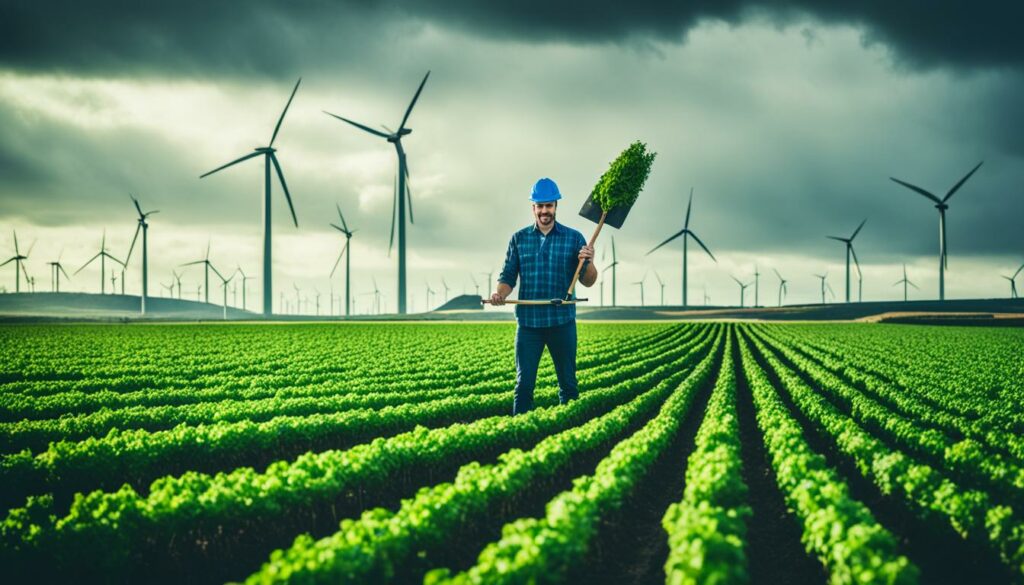
Agriculture is a big source of worldwide greenhouse gases. Things like animal digestion, chemicals, and changed lands add to this. Bugs and weeds are often killed using pesticides, which can actually make greenhouse gases worse. In total, farming is behind about 12% of these emissions, possibly even a third when you count other effects.
Switching to organic methods can help a lot in lowering emissions. By not using artificial nitrogen, these farms cut their own greenhouse gas output by 20%. They also use strategies that keep the land and the bugs living on it healthy. This lessens the need for things like fuel and at the same time, these farms store more carbon in the ground.
Estimates suggest that with widespread adoption of diversified organic farming, soils could absorb more carbon than the agricultural sector emits from 2020 to 2100.
Research shows organic farms use nearly half the energy of usual farms. And pesticides don’t harm the soil’s tiny creatures as much. Overall, organic ways keep carbon in the soil and produce less harmful gases. By growing certain plants alongside crops, these farms naturally add nutrients to the soil, meaning less artificial fertiliser is needed.
Organic agriculture does a lot to lower greenhouse gases in farming. It’s essential for a greener, more sustainable future.
| Practice | Impact on Emissions | Additional Benefits |
|---|---|---|
| Elimination of synthetic fertilisers | Reduces emissions by about 20% | Enhances soil health |
| Using cover crops | Enhances soil organic matter | Reduces need for nitrogen fertiliser |
| Natural pest control | Reduces N2O emissions | Improves biodiversity |
| No pesticide use | Reduces N2O emissions by 700-800% | Protects soil invertebrates |
| Agroecological practices | More carbon capture | Achieves higher soil organic carbon |
Organic farming boosts soil health in a big way. It uses practices that are good for the earth. Such practices help improve soil’s structure and encourage more plants and animals to live there. One of its key goals is soil carbon sequestration, which helps keep atmospheric carbon in check. This makes the soil richer and better for growing food.
Keeping carbon in the soil is great for both fighting climate change and for healthy soil. Organic farmers do this in several ways, like changing which crops they grow, using cover crops, and adding lots of compost. These methods help the soil hold onto water better, lower the need for chemicals, and make the soil more fertile.
Adding organic matter to the soil is a game-changer for its health. It boosts nutrients and makes the soil’s structure better. Farms that go organic use much less energy. If all farms did this, our global carbon emissions from farming could drop by 20%. Also, organic farming helps water go deeper into the ground. This is good for keeping our water supply healthy and the environment flourishing.
Organic farming can also grow more food, especially when the weather is tough, like in droughts. In dry years, organic farms can produce up to 40% more food than other farms. This shows that taking good care of the soil is not just about saving our planet. It’s also good for making sure there’s enough food for everyone.
| Practice | Benefit |
|---|---|
| Crop Rotations | Enhances soil structure and nutrient cycling |
| Cover Cropping | Increases soil organic carbon and water retention |
| Use of Compost | Boosts soil fertility and organic matter |
| Elimination of Synthetic Fertilisers | Reduces greenhouse gas emissions by 20% |
Using crop rotations in organic farming is very important. It helps manage crops sustainably. By changing the types of plants on a field, we can cut down on pests and the use of pesticides. This method keeps crops healthy and helps the environment in the long run.
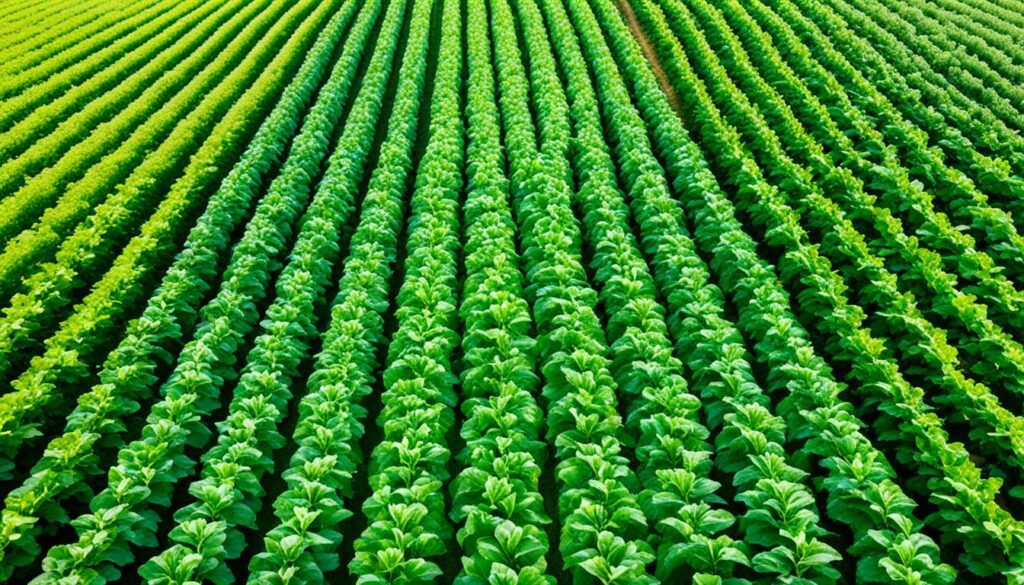
Different plant mixes can boost harvests in many places. An example is the North China Plain, where changing crops increased yields by up to 38%. This success shows that sustainable farming works well.
Adding beans and peas to the mix makes the soil better. It cuts harmful emissions by 39% and boosts soil health. This makes a strong environment for plants to grow well.
Rotating crops well can also help make more money. Using sweet potatoes, peanuts, or soybeans instead of only wheat and maize can raise income by 13-60%. It also means more protein can be produced, between 8-31% more.
| Rotation System | Yield Increase | Economic Benefit | Environmental Impact |
|---|---|---|---|
| Diversified Crop Rotation | Up to 38% | 13-60% Net Income Increase | Lower N2O emissions by 39% |
| Legume-Included Rotations | 8-31% Protein Yield Increase | Enhanced Soil Organic Carbon by 8% | Improved Nutrient Cycles |
Relying only on grains can be harmful, lowering yields and proteins. That’s why a mix of crops is so important. It keeps the soil and plants healthy.
In the end, using crop rotations is key in organic farming. It helps with pests and soil issues. This means a better, eco-friendly future for farming.
Finding better ways to manage farm nutrients is key to lowering the carbon footprint of agriculture. Organic farming focuses on the ‘4Rs’—choosing the right source, amount, time, and place for nutrients. This leads to better nutrient use and protects our planet.
The ‘4Rs’ highlight how to manage nutrients wisely. It’s about:
Following these steps can cut waste and harm to the environment. This is crucial to cope with a 56% rise in food needs by 2050. It also helps tackle the 31% of human-made greenhouse gases coming from farming.
Using organic fertilisers, like compost and green manure, is vital for proper nutrient management. These fertilisers add key nutrients and help grow healthy soil. This improves water holding and cuts soil erosion, key for sustainable farming.
Advanced methods, like controlled-release fertilisers, make nutrient use even better. They reduce waste, keeping nutrients in the soil.
So, adding organic fertilisers to the ‘4Rs’ helps care for nutrients and the environment. It’s a big reason organic farming is 20% greener than usual farming. This shows how important good nutrient management is for the future.
Transitioning to organic farming aims to cut down on the use of fossil-fuel inputs. It promotes methods that are more sustainable. This reduces our dependence on synthetic chemicals and helps nature keep its balance.
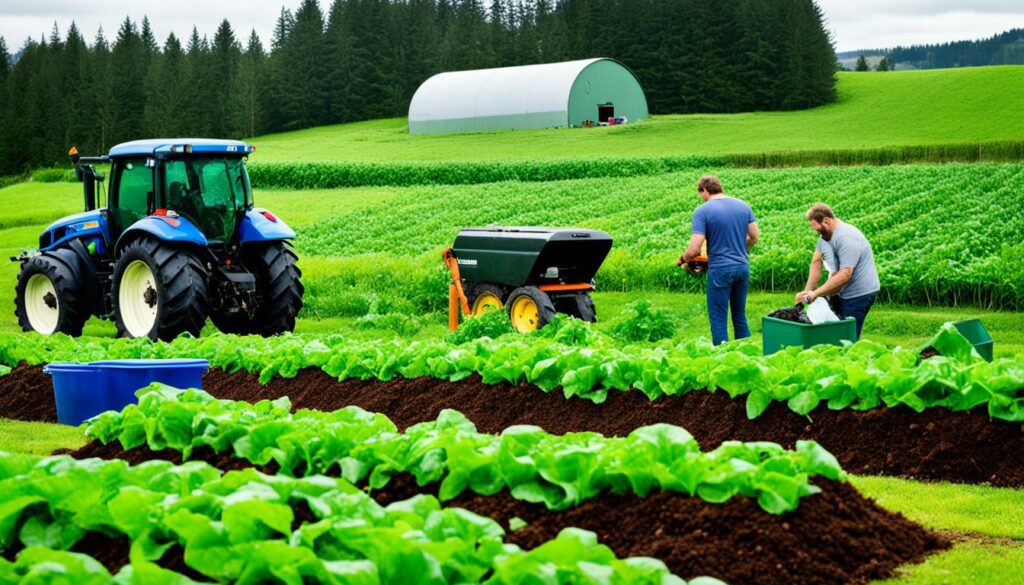
Organic farming does away with synthetic fertilisers. Studies suggest this change could cut down global agriculture’s greenhouse gases by 20%. It also means less need for fossil fuel-based ingredients often found in artificial fertilisers.
The California Air Resources Board urges a shift towards 20% organic farming by 2045. This shows such steps are vital for the future.
Organic farms are turning to renewable energy sources. They use 45% less energy than typical farms, a study finds. This includes using solar, wind, and bioenergy.
This move not only lowers climate impact but also boosts farms’ long-term sustainability and output.
| Traditional Agriculture | Organic Agriculture |
|---|---|
| Relies heavily on synthetic fertilisers | Eliminates synthetic fertiliser alternatives |
| High energy consumption | 45% less energy consumption |
| Limited use of renewable energy | Increased adoption of renewable energy in agriculture |
| Higher greenhouse gas emissions | Reduced emissions through natural practices |
Cover crops are vital in organic farming for preventing soil erosion and boosting soil health. They cover the land during idle times, stopping soil from washing away. This is crucial in the Northeastern United States, where heavy rains are common.
They help make the soil richer by holding onto extra nutrients. This means less compacted soil and a better balance of water and air. With more organic matter in the ground, soil stays together better. It can deal with water well, even in dry times.
Cover cropping is also great for taking in carbon from the air. This makes for a greener farm with less impact on the planet. They also stop water from getting dirty and bring in good bugs that eat the bad bugs.
They have good points for making more crops and saving on equipment. But, you need to be smart about which crops to use and how. Think about the weather and the way you look after the land. Talking to experts and trying small changes can make your farm better for the earth and still a good business.
While cover crops do a lot of good, they can be tricky. They might cost more and there’s a chance they could lock up nitrogen. So, every farm needs a plan that fits just right. This way, they can enjoy all the benefits and avoid any problems.
In organic farming, cutting down on tillage is crucial to lessen soil harm. Farmers have tilled land for centuries, especially those growing wheat, rye, and barley in Western Asia, Europe, and Northern Africa. The way we till the soil has changed a lot over time, with new methods like the moldboard plow’s design being tweaked in England in the 1700s.
For farmers looking to reduce their impact on the environment, switching to no-till farming is key. Even back in Pre-Columbian America, farmers used methods that avoided digging up the whole field. Today, we have lots of improved tillage tools that help us avoid harming the soil too much. This lets us farm in ways that are both good for the land and for the planet.
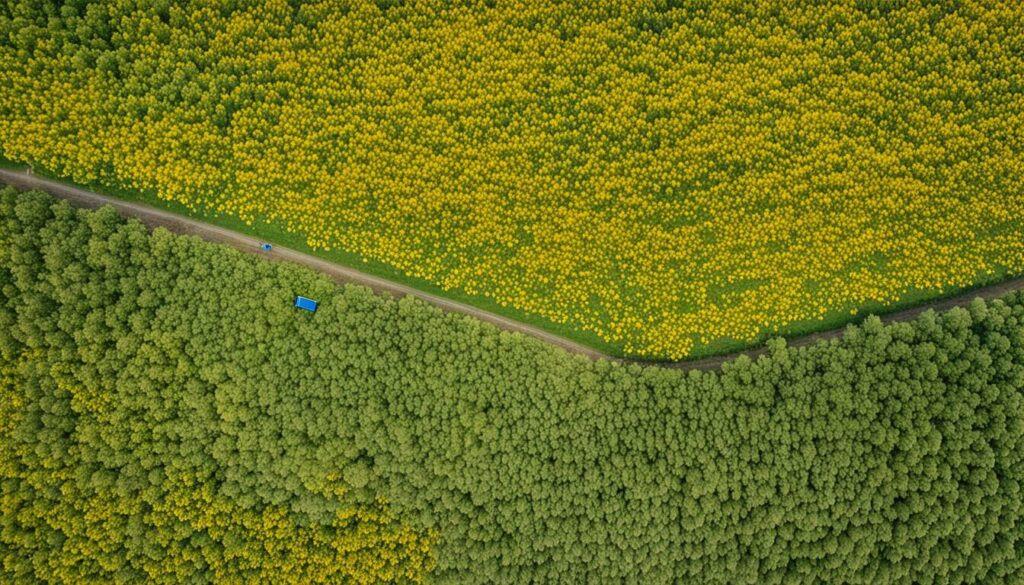
No-till farming is much better than old-fashioned methods in many ways. Thanks to modern tech, like new herbicides and planters, it’s easier for farmers to go no-till. When fields aren’t dug up all the time, the amount of carbon in the soil goes up. This is really important for keeping our soil healthy. In fact, after looking at 351 studies, experts found that the soil had more carbon in it if it wasn’t tilled down to 30 cm deep.
| Tillage Intensity | SOC Concentration (Upper Soil Layer) |
|---|---|
| No-Till (NT) | 1.18 g/kg ± 0.34 (SE) |
| Intermediate Tillage (IT) | 1.30 g/kg ± 0.22 (SE) |
| High Tillage (HT) | 2.09 g/kg ± 0.34 (SE) |
No-till farming is great because it stops soil from washing away. While old ploughs were good at mixing in fertiliser, they also caused a lot of problems, like erosion and losing soil nutrients. Keeping the soil in good shape by not digging it up all the time protects it from being washed away.
Not digging up the soil also makes it hold water better. Soils stay healthy and full of life when we don’t disturb them so much. This means water can soak in better and doesn’t wash away the topsoil. Quite a few techniques, like chisel ploughing, are kinder to the soil. They don’t completely turn it over, which helps keep it fertile and stopping the wind from carrying it off.
Moving from old to new tillage ways is really good for the planet. It helps lessen carbon in the air and keeps water in the soil. Everyone in farming should think about these methods for a better, greener future.
Organic livestock management focuses on farming where animals get most of their food from grass. This keeps them healthy and happy. It also means the farm relies less on buying food for the animals. This helps the farm be more eco-friendly. It’s good for the earth and for the animals.
In this type of farming, animals eat grass from the land. This helps them stay in good health. It also helps the land and its plants grow well. The method takes care of both the animals and their environment. It’s a win-win situation for everyone involved.
Recycling nutrients in farming is vital for the land’s health. In organic farming, animal waste is used to make the soil better. This way, farmers don’t need to use as many chemicals on their land. It’s all about keeping the farm’s ecosystem in balance naturally.
| Benefits | Data/Statistics |
|---|---|
| Energy Efficiency | Organic farms use 45% less energy compared to conventional farms (Rodale Institute). |
| Climate Mitigation | The elimination of synthetic nitrogen fertilisers in organic systems could lower global agricultural GHG emissions by about 20%. |
| Soil Health | Organic agriculture results in higher stable soil organic carbon and reduced nitrous oxide (N2O) emissions. |
| Animal Welfare | Adhering to USDA Organic certification guidelines ensures animals are managed in a way that conserves natural resources and promotes biodiversity. |
Looking at organic farming’s carbon footprint, we see its benefits and difficulties. Organic methods can lessen greenhouse gases but face some challenges too. Moving to organic farming helps nature a lot. It reduces pollution and improves soil, but it’s not without issues, especially in how much is produced.

Research shows different carbon amounts depending on farming choices. For example, Eldesouky et al. (2018) found low emission numbers in Spanish agroforestry, between 28 and 38. On the other hand, Vagnoni and Franca (2018) measured high carbon outputs, up to 1294, in North Germany’s cow-calf farms. This shows that not all types of farming are the same.
Looking at beef production in Italy, Buratti et al. (2017) noted carbon footprints from 129 to 137. In Spain’s dairy goat farms, Gutiérrez-Peña et al. (2019) found broader figures, from 993 to 998. Dougherty et al. (2019) pointed out high carbon footprints in California sheep farming, around 945 to 961, adding to the diverse results.
Comparative Analysis
| Study | Region | Carbon Footprint Range |
|---|---|---|
| Eldesouky et al. (2018) | Spain | 28–38 |
| Vagnoni and Franca (2018) | North Germany | 1294 |
| Buratti et al. (2017) | Italy | 129–137 |
| Gutiérrez-Peña et al. (2019) | Southern Spain | 993–998 |
| Dougherty et al. (2019) | California, USA | 945–961 |
Organic farming offers many upsides like using less synthetic fertilisers and storing more carbon in the soil. However, care in management is crucial. The issues with farming’s carbon footprint, especially in handling land use and making up for less yield, need careful attention to prevent adding environmental problems elsewhere.
Using new technology and green methods is key in making big environmental improvements. It’s important to have a realistic opinion about organic farming’s carbon footprint. This kind of thinking helps with smart choices and creating good policies.
The need for sustainable farming is ever-growing. Thus, using data to farm is very important. It boosts farm performance and cuts down on the waste that harms the environment.
Precision farming uses tech to make the most out of resources. It makes sure things like water and chemicals are only used where required. This approach stops the unnecessary use of resources and minimizes harm.
Farmers look deeply into their emissions with carbon audits. This helps them figure out how to cut these emissions down. Planting trees and cover crops are part of a precision farming approach. They absorb carbon and make the soil healthier.
AgTech brings many advantages to farming. It collects data in real time and offers sophisticated analysis. This data helps farmers make smart choices and manages resources better, reducing their environmental impact.
By using AgTech, moving towards renewable energy is easier. This switch, to solar or wind power, significantly shrinks the farm’s carbon footprint. With the right education, it makes it easier for farmers to adopt planet-friendly practices. Alongside AgTech, this includes cutting waste and recycling more to lessen their environmental damage.
| Technique | Benefit | Impact on Emissions |
|---|---|---|
| Precision Agriculture | Optimal Resource Use | Reduces Waste and Emissions |
| AgTech Solutions | Real-Time Data Analytics | Enhances Decision-Making |
| Renewable Energy | Reduces Dependency on Fossil Fuels | Decreases Carbon Footprint |
| Carbon Audits | In-Depth Emission Analysis | Identifies Mitigation Measures |
Government rules and incentives for sustainable agriculture are key for shifting to organic ways. People are more aware of how farming affects the planet. This has made changing how we farm very important. Governments are offering help to farmers who want to go organic.
In more countries today, there’s a greater focus on government support for organic farming. They do this by:
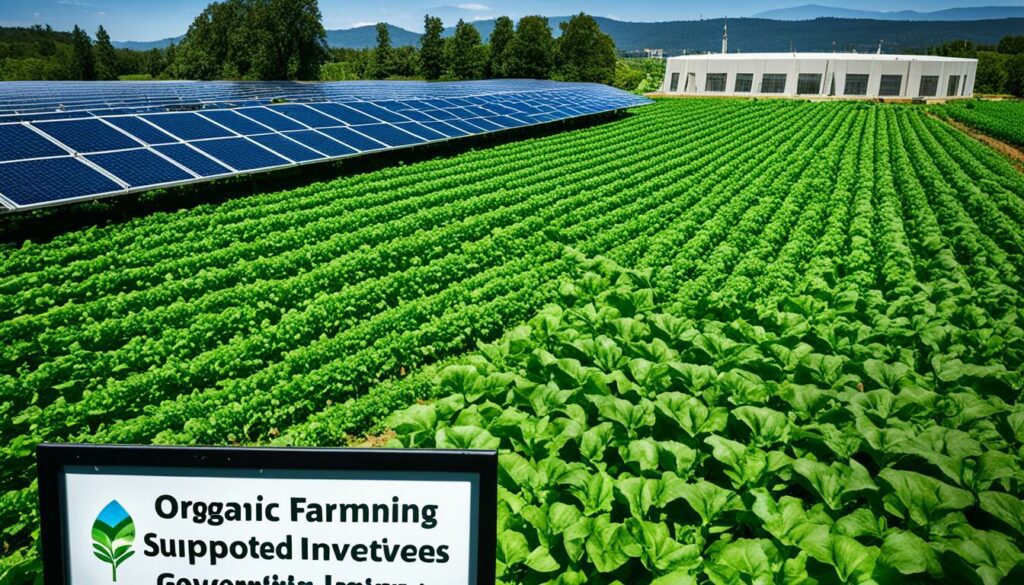
Take California, for example. From 2014 to 2019, the area under organic farming there grew by 44%. This was thanks to state policies and support. The California Air Resources Board also set a goal to have 20% of farming done organically by 2045. This shows the state really stands behind sustainable agriculture.
Research and examples show that incentives for sustainable agriculture work. For instance, not using chemical fertilisers in organic farming could cut farming’s greenhouse gas emissions by 20%. Additionally, organic farms use much less energy, a study by the Rodale Institute found a 45% difference.
These efforts, backed by strong government rules, do more than increase food and protect the soil. They also help the planet by cutting pollution and saving on energy. Showing how effective policy can be, these actions push for a greener farming future.
| Initiative | Impact |
|---|---|
| Conversion to organic agriculture by 2045 | 20% of California’s agricultural lands targeted |
| Energy consumption reduction | 45% less energy used by organic farms |
| Emission reductions from eliminating synthetic fertilisers | About 20% global agricultural GHG emission reduction |
We’re heading towards a future where farming must be both sustainable and efficient. Important advancements include controlled release fertilisers and biodegradable farming gear. These offer big changes in the way we manage nutrients and our impact on the earth. They help not only grow better crops but also keep the environment in balance.
Controlled release fertilisers are a game-changer for sustainable farming. They release nutrients slowly, matching the needs of growing crops. This means we apply them less often, which cuts down on waste and makes better use of resources. By using tools like soil sensors and satellite maps, we can make fertiliser use even smarter. This boosts both crops and the planet.
| Technology | Benefit | Environmental Impact |
|---|---|---|
| Sensors & Drones | Optimise fertiliser application | Minimise runoff & waste |
| Satellite Mapping | Precise nutrient delivery | Enhanced resource efficiency |
| Soil Sensors | Track nutrient levels | Improved soil health |
The rise of biodegradable farming gear is key for the planet. From mulches to containers, these products break down safely. They lower plastic waste and avoid polluting our soil and water. These advancements support organic farming. Plus, tech like bee vectoring and improved wastewater systems push us closer to circular farming.
In sum, the progress in areas like controlled fertilisers and biodegradable gear is crucial for farming’s future. These innovations let us use resources better, boost crop production, and lower the carbon footprint of farming.
Looking at ways to cut agriculture’s carbon footprint, we find many important methods. Research in Spain focuses on how livestock and trees together can make farming greener. It shows a carbon footprint between 28 and 38. In Italy, a study looked at regular and organic beef farming. The difference in their environmental impact was clear. The range was from 129 to 137.
Organic farming stands out in certain areas, like dairy goat farming in Southern Spain and milk production in Northeast Spain. In these areas, the emissions are much lower, which is great news. Going organic in England and Wales has also shown big environmental benefits. All of this is very important in our fight against climate change. The global temperature has increased by 1.09 °C in ten years, mainly because of human activities.
By not using harmful chemicals, organic farming helps reduce pollution and keeps our natural world diverse. The EU aiming to lower farming emissions by 30% by 2030 is a big step. We can get there by using better practices and new technologies, like cover cropping and no-till farming. With the right laws and support for farmers, we can move towards greener agriculture. This effort is crucial for a better future for everyone.
The term ‘carbon footprint’ means the total greenhouse gas (GHG) emissions from someone, a company, or a product. It includes emissions of gases like carbon dioxide, methane, and nitrous oxide from different activities.
It’s vital to cut the carbon footprint in farming as it plays a big part in global GHG emissions. By lowering these emissions, we can help fight global warming and the change of our climates. This makes farming more sustainable and stronger against challenges.
Farming is a big player in global GHG emissions, through processes like livestock digestion and manure management. These activities add a lot to emissions of carbon dioxide, methane, and nitrous oxide.
Organic farming is a big help in lowering GHG emissions. By not using synthetic fertilisers and pesticides, it cuts down energy use and pollutants. It can even lead to more carbon being trapped than released into the air.
Practices like crop rotations and using compost help trap carbon in the soil. These methods boost the health and fertility of the soil.
Adding organic matter to the soil makes it better for plants and the environment. It improves the soil’s structure and helps it hold more nutrients and water. This means healthier soil overall.
Rotating crops can stop pests, balance out nutrient use, and increase the amount of organic matter in the soil. It makes the farming system more able to bounce back from challenges and keeps the land fertile.
The 4Rs approach means using the right source, right rate, right time, and right place for nutrients. This method makes sure nutrients are used as best as possible, cutting down on waste and harm to the environment.
Compost and green manure fit within the 4Rs approach, providing needed nutrients and improving soil health. They are part of a sustainable way to manage nutrients in farming.
Organic farming doesn’t use synthetic fertilisers, meaning less dependence on fossil fuels. Plus, it encourages the use of renewable energy like solar and wind for the farm.
Cover crops stop soil from being washed away, boost how nutrients are used, and pull nitrogen from the air. They also help fight unwanted plants, and lock carbon into the ground.
No-till farming reduces how much the soil is disturbed, lowering erosion and keeping water better. It supports more diverse life in the soil. It also helps the soil trap more carbon.
Nutrient cycling means using animal waste to put nutrients back in the soil. This keeps the soil healthy and makes better use of the nutrients available. It’s common in farming with animals on pasture.
Moving to organic farming can cut GHG emissions, but farmers must be careful. They need to avoid harming other areas due to possible changes in how much they produce. A smart, balanced approach is key to success.
Precision agriculture uses tools to collect up-to-date data on soil, plants, and the weather. This information helps farmers use resources better, waste less, and take good care of the land.
Governments back organic farming with things like money, tax breaks, and help with know-how. These things help lower the cost of changing to organic ways and encourage farming that’s gentle on the earth.
New ideas like fertilisers that let plants use nutrients more efficiently and products that break down easily can help farm more wisely. They cut down on waste, keep the soil in good shape, and make farming less damaging to the planet.